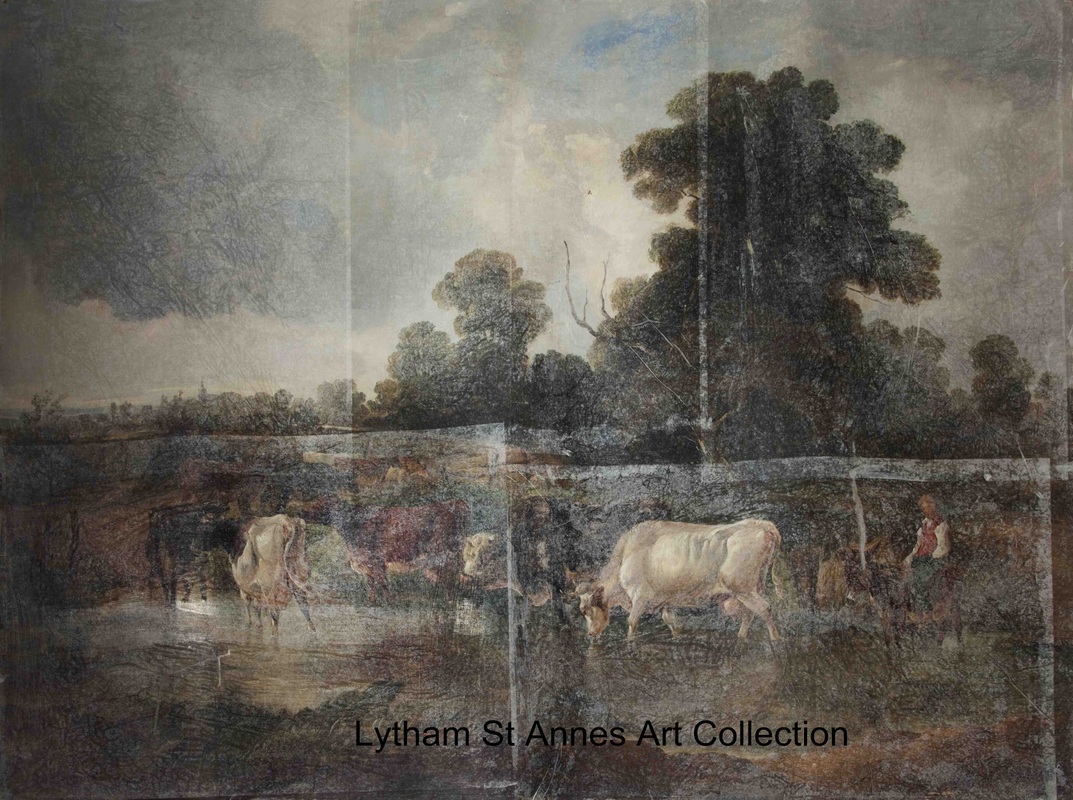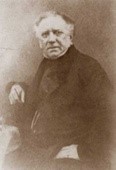The Watering Place
|
Research by Marjorie Gregson
|
|
ARTIST
William Shayer was a self-taught English artist of great versatility. He was born in Southampton in June 1787 where he began his career painting decorations on rush bottom chairs, then moved to Guildford where he became a carriage painter, after which he started doing heraldic painting. He was chosen to create the funerary badge of the fourth Duke of Richmond. In 1814 Shayer was commissioned to chalk a design on the floor of a ball being held to celebrate the overthrow of Napoleon. Meanwhile, he devoted his free time to landscape painting whilst making his living painting theatrical scenes, as a reproduction artist, and also as a painter of signs for inns and other establishments.
He experienced a period of financial difficulty when his first wife, Sarah, died and he was left to support and care for five children. However, he did not remain a widower for long and with Elizabeth, his second wife, he produced five more children. With the opening of the Hampshire Painting Gallery, Shayer's situation improved; he sold thirty paintings in the first season. In 1843 he settled in Southampton at Bladon Lodge, in an area renowned for the beauty of it's skies. As his fame grew Shayer resisted offers by his peers to go to London. He loved the landscape of southern England and produced many genre paintings of rural life in the manner of Francis Wheatley, Julius Caesar Ibbetson and predominantly, George Morland. His favoured themes depicted harvesting, milking, dragging timber, scenes of village life and interiors of inns. Shayer would also paint genre scenes of guards, gipsies, hunts, Bohemians, shepherds and beach scenes crowded with fishermen and boats. The skill he had acquired in the lesser genres provided him with a thorough technical grounding. Shayer’s career was helped considerably by the patronage of a wealthy Southampton merchant, Michael Hoy. He sometimes collaborated with other artists. Particularly successful were those with Edward Charles Williams, where Williams would paint the landscape and Shayer would add people and animals. Shayer’s eldest son, William Joseph Shayer (1811-1892), was also an artist and painted in a similar style to his father, so their works are often confused. What makes it even more confusing is that the two probably worked together on several paintings in Shayer senior's later life. Three other sons, Edward Dasherwood Shayer (1821-1864), Henry Thring Shayer (1825-1894) and Charles Walker Shayer (1826-1914) also became painters, and all, at times, assisted him in his studio. William Shayer died in 1879, aged 92, at his home, Bladon Lodge. He was a very popular artist and his work has a depth and brightness due to his skilful application of glaze where he spread a thin, oily, transparent layer of paint over a dry opaque paint. He had 6 works exhibited at The Royal Academy, 82 works at The British Institution and a remarkable 338 works at The Suffolk Street Gallery of the Society of British Artists. The following are just a few of Shayer's paintings to be viewed in galleries nationwide: Village Festival Tate London A Donkey and a Youth Shipley Art Gallery A Group of Gypsies Rochdale Arts and Heritage Service Beach Scene Ferens Art Gallery Cottage Door Scene Colchester and Ipswich Museum Service Harvesting Calderdale Metropolitan Borough Council PAINTING The painting is in need of restoration but one can still see the artist’s skill in this peaceful rural scene. The cattle in the stream are finely depicted and are grouped and painted in colours which draw the eye to the middle ground. They are watched over by a lone figure on a horse or donkey to the right of the picture. The sky illuminates the scene below and its cool colours contrast with the stronger colours and textures of the trees and vegetation. It is a harmonious composition of depth and space. DONOR Henry Randle Heys, the donor of the painting, was born in 1916 in Ramsbottom, Lancashire, to Henry Howarth Heys (1880 -1937) and Eveline Ellen, nee Armstrong (1879-1939). The 1911 census describes Henry Howarth Heys as 'a cloth buyer'. He was a captain in the 5th Battalion of the East Lancashire Regiment in WW1. He died in Lytham in 1937, having lived at Westfield, Clifton Drive from at least 1929. His father, William Randle Heys (1846-1883), was also a yarn merchant of Ramsbottom and was a stalwart of the community. In St Paul’s Church, Ramsbottom there is a window dedicated to William’s memory entitled 'Christ Walking on the Sea'. Henry Randle Heys, who served in WWII, died in 1951. His last known address was 14 Clifton Drive, St Annes. It was through his generosity that a communion rail was installed in St Paul’s to mark the long association of his family with the church. |
Acc No 22
Artist William Shayer Artist dates 1787-1879 Medium oil on canvas Size 111.8 x 149.9 cm (44 X 59 in) Date painted unknown Inscr: signature and date Donor Henry Randle Heys Clifton Drive, Lytham Date donated 16 June 1946 REFERENCES www.19thcenturypaintings.com www.allartclassic.com www.masterart.com www.newmedia.artsolution.net www.bbc.co.uk/art/yourpaintings Grove Art Online Barratt’s Directory Blackpool and District 1934 Ramsbottom Heritage Society Magazine 22, Autumn 2001 |


